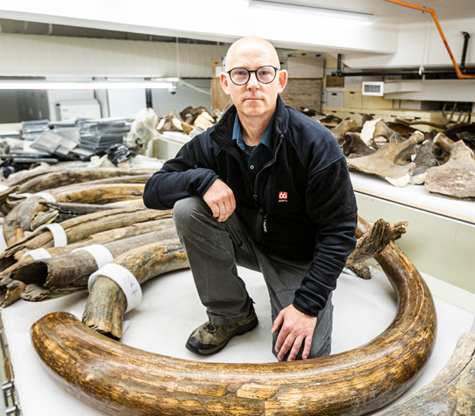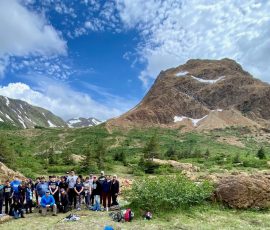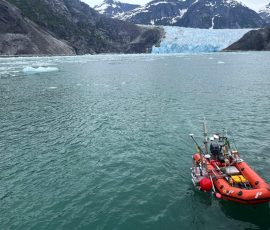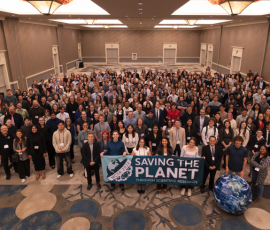The Murdock Trust invests in capacity-building projects at nonprofit organizations across the Pacific Northwest. When one grant helps create new opportunities and increase the impact of a nonprofit’s work down the line, we call it the ripple effect. The Stories of Impact series on our website is intended to help shed light on the outcomes driven by some of the outstanding organizations the Murdock Trust has been fortunate to support in recent years.
Where did mammoths roam? How can we more accurately track human diet? What do Steller sea lions eat? How can we help conserve black cod fish? These are just some of the questions that researchers at the University of Alaska Fairbanks (UAF) are helping to answer, thanks to a new piece of equipment and a stellar team of researchers. A 2018 Murdock Trust grant for a mass spectrometer catalyzed some of the work these researchers had been doing their entire careers, leading to diverse and groundbreaking discoveries involving woolly mammoths, human diet, and more.
University of Alaska Fairbanks
UAF is the principal research center in Alaska’s university system. With a research emphasis on the circumpolar North and its diverse peoples, UAF is known as America’s arctic university and is a world leader in climate change and arctic research. Scientists there are addressing pressing questions of conservation concern, human dietary health, Alaska Native peoples, and the Arctic. Perhaps most fascinating of all, recent research is yielding brand new insights into the lives of Arctic woolly mammoths roaming Alaskan land 17,000 years ago.
Walking with a Woolly Mammoth
Imagine splitting a tree trunk and counting the rings to determine its age. It’s a similar process, though much more complex, to determine the lifetime movements of a woolly mammoth using its tusk. Thanks to the right team and the right equipment, for the first time this research has been done.
As Patrick Druckenmiller of Museum of the North explains, tusks are simply modified teeth that grow continuously throughout a mammoth’s life. “It’s a diary of the life of that individual,” he said. “Every day it adds another little line of growth.”
If researchers can split the tusk to read the individual pages of that diary, they can learn where the mammoth was living, what it was eating, and aspects of its environment. The secret to reading that diary is running tiny tusk samples through a mass spectrometer to determine the ratios of different isotopes that comprise the sample. Those isotope ratios can then be matched to different isotope ratios in the mammoth’s environment, telling us where they were roaming and what they were eating. The result is an astonishingly vivid picture of the life of a woolly mammoth – in this case, a male mammoth nicknamed Kik.
“We were super excited to see the data emerging from the mass spectrometer in real time,” Dr. Matthew Wooller, professor of chemical oceanography, marine biology, and marine ecology and director of the Alaska Stable Isotope Facility, said in a press briefing. “It clearly showed we were dealing with a mammoth that had moved a great deal during its lifespan. It was like watching a lifetime movement and life history appear before our eyes, kind of like a TV series.”

During the last period of its life, the team noticed an increase in the nitrogen isotope signature, indicating the beginning of starvation. In the last year of Kik’s life, his movement was reduced. He eventually died above the arctic circle at 28 years old.
Inspiring Research
As Dr. Wooller explained, this research is not just interesting knowledge about the Arctic’s past. It also contributes to our understanding of the mammoth’s extinction; it would have been difficult for mammoths to sustain this high level of movement after the changes of the last ice age. Even more relevant, this research sheds light on concerns for Arctic animals alive today. If mammoths adapted their behavior in response to climate changes 17,000 years ago, how might animals today respond to the unprecedented changes we are seeing?
“In Alaska, we have a lot of really cool wildlife,” said Dr. Wooller. “But we have a lot of wildlife that is suffering. The climate change is having a larger influence at high latitudes, and some of the largest temperature changes are seen up in the Arctic. So all of that wildlife needs to be understood in terms of what it is eating, where it is moving, whether it is starving.”
With this exciting mammoth study as a model, researchers are approaching the lab at UAF to conduct similar studies on species that are still alive. Steller sea lions and sablefish, or black cod, are two species of conservation concern that need more research, and the lab at UAF can make it happen.
“The mammoth research can be an exciting vehicle for expanding technology and capturing people’s interest,” said Dr. Wooller. “Because it’s an iconic species, it can inspire us. But there’s a lot more applied research out there on conservation, biomedical applications, and more.”
In this way, Dr. Wooller explains, the research done at the UAF lab can cause impact down the line – and not just in his lab, but for the global scientific community, and for the future of wildlife everywhere.
Documenting Diet
The analysis in this research requires the use of a special piece of equipment called a gas chromatograph isotope ratio mass spectrometer, which the Murdock Trust was glad to support with a grant in 2018. As it turns out, this same instrument is being used by Dr. Wooller’s wife, Dr. Diane O’Brien, professor of biology and wildlife and interim director at UAF’s Institute of Arctic Biology, for groundbreaking biomedical research that has caught the attention of United States Center for Disease Control (CDC).

Just as Dr. Wooller can do isotope testing on a mammoth tusk to analyze diet, so too can Dr. O’Brien gather human dietary data from isotope tests on blood samples. With remarkable accuracy, isotopic analysis can give her data on sugar intake, meat intake, and other important biomarkers for human health. This helps to solve a problem that had been facing the entire field of human diet research until now.
“For years,” said Dr. O’Brien, “there has been a lot of interest in the biomedical research community in coming up with objective measures of diet. These would be some kind of biomarkers that don’t rely on people’s perception of their diet, but are based instead on a chemical signature in the blood or some other objective measure.”
Though Dr. O’Brien’s research interest is primarily in Alaska Native populations and their traditional diet, this method of isotope analysis as an objective biomarker is starting to catch the attention of labs around the country. Recently, the CDC approached her, wanting to incorporate this groundbreaking method into their major National Health and Nutrition Examination Survey (NHANES).
“The NHANES is a huge undertaking to capture the typical diet of the U.S. population, enrolling 5,000 people each year,” said Dr. O’Brien. “It recruits in a way that represents the U.S. population as a whole, based on gender, race, ethnicity, etc. They contacted me after seeing my papers and said, ‘We want to build towards being able to add compound-specific stable isotope ratios to the type of measurements that we routinely collect.’”
Eventually, if the CDC adopts and scales this method, these kinds of dietary data could be automatically generated and made publicly accessible. This would help improve the accuracy of public health recommendations, inform our understanding of dietary influences on chronic diseases, and more.
“When this method takes off,” said Dr. Wooller of Dr. O’Brien’s research, “it’s going to boom. You’re going to need a lot more of these instruments to crank through those samples. But having this one instrument has allowed us to build bigger projects for both our research.”
Building Capacity
For both Dr. Wooller’s and Dr. O’Brien’s research, this instrument has not only helped them as they create trailblazing new applications of isotope analysis, but it has also grown their capacity to serve more researchers. When a student comes to Dr. Wooller now asking to use a spectrometer, he can say, “Sure, we can schedule a time for a couple of months from now.” Before, the testing may have been delayed a year. Both Dr. Wooller and Dr. O’Brien oversee student research using this spectrometer, and it’s even proved to be a compelling recruiting tool for new faculty and students and helped them secure new NIH grants.
“The ripple effects of this grant,” said Dr. Wooller, “are that it is kind of a tidal wave of capacity building.”
The Murdock Trust is honored to have played a small role in supporting this groundbreaking research and is grateful for our ongoing collaboration with University of Alaska Fairbanks through more than 30 grants totaling over $5 million since 1984. To Dr. O’Brien, Dr. Wooller, and all their research partners collaborating to inform our understanding of human and animal health, today and in our past, thank you. May your work continue to flourish!







